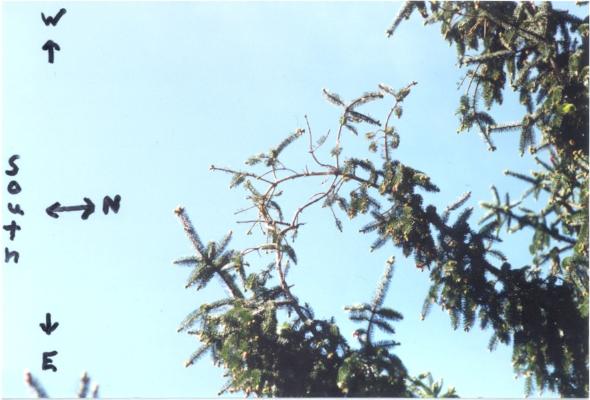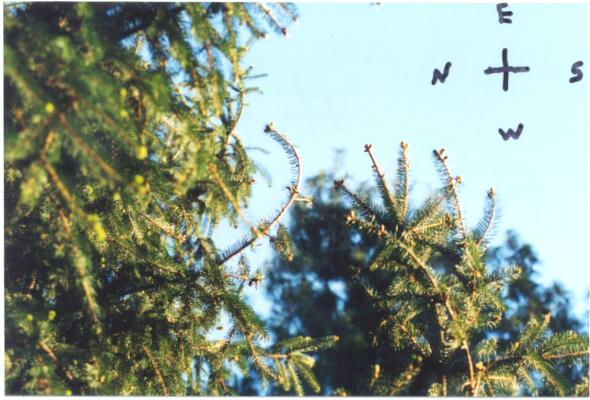
Norway Spruce Tip Curl
(Picea abies)
Please see text below photos

Photo taken at Rock
Creek WV in July of 1999--by Joe Aliff
The "Branch Tip Curl" and needle loss, as shown in this photo, is caused by a variety of abnormal environmental conditions that are the direct results of air pollution which we shall speak of, in part. The "Branch Tip Curl" results from the drying effects that occur when a tree is no longer able to draw sufficient water to sustain it's mass. The inability of a tree to draw water is a direct result of soil acidification that changes the chemical balance of soil. This "change" results in excess Nitrogen that affects trees by the reduction of fine roots that causes a tree to experience drought like conditions even though the rainfall is sufficient. Acid rain will also decrease needed nutrient cations in the soil and release toxic elements, such as aluminum, which clogs the trees plumbing and prevents the uptake and use of water and nutrients by the tree. Many other factors help to impose stress on the tree, such as ground level ozone, (smog) and the great increase in the ultra violet radiation from the sun due to the air pollution induced "hole" in the upper level ozone. Nitrogen saturation also increases trees' susceptibility to insects and disease.

Photo taken at Rock Creek WV in May of 1999--by Joe Aliff
This is another example of "Branch Tip Curl" and is 20 ft above the ground on the south side of the tree. The photo clearly shows the "curl" and the needle loss on that part which faces the sun. However, to be remembered is the fact that being in direct sunlight is not the only factor which results in "curl" or needle loss although the south side does show the most damage.

Photo taken at Rock Creek WV in May of 1999--by Joe
Aliff
In this photo of "Branch Tip Curl", we are able to see a larger portion of the tree. Each summer, the branches do curl up, and each winter, the branches do un-curl, to a certain degree. If we look closely at the branches of the tree in the photo, we can see the "S" shape effects that are left on the branch from this "curl and un-curl" phenomena.

Photo taken at Rock Creek WV in late winter of 1999--by Joe Aliff
In this photo, we are looking at a North East exposure that shows the "S"curves of branchlets that have attempted to "un-curl". Although not directly in the harsh sun, we are able to see the curl and the needle loss.
Observed and reported by:
Joe Aliff
759 Rock Creek Road
Rock Creek
WV 25174
email: joelovestrees@earthlink.net
. . . back to AIR POLLUTION AND FOREST HEALTH NOTES FROM AROUND THE WORLD
. . . to Eco Systems' Home Page
Contact Gerry Hawkes: ghawkes@eco-systems.org